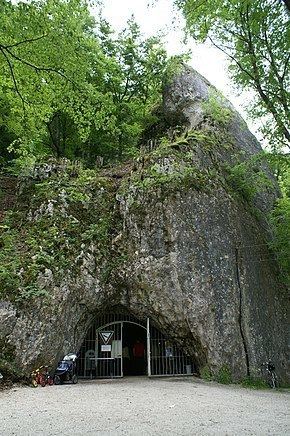 | ||
Similar Geisenklösterle, Swabian Jura, Urgeschichtliches Museum Blaubeuren, Archäopark Vogelherd, Blau | ||
The Hohle Fels ( [ˈhoːləˈfɛls]) (also Hohlefels, Hohler Fels, German for "hollow rock") is a cave in the Swabian Jura of Germany that has yielded a number of important archaeological finds dating to the Upper Paleolithic. Artifacts found in the cave represent some of the earliest examples of prehistoric art and musical instruments ever discovered. The cave is just outside the town of Schelklingen in the state of Baden-Württemberg, near Ulm.
Contents
- Map of Hohler Fels 89601 Schelklingen Germany
- Features
- Discoveries
- Archaeogenetics
- UNESCO World Heritage application
- References
Map of Hohler Fels, 89601 Schelklingen, Germany
Features
The cave entrance is at 534 m (1,752 ft) above sea level. The cave consists of a tunnel of about 15 m (49 ft) length and a main hall with a volume of 6,000 m3 (210,000 cu ft), making the cave hall one of the largest of Southern Germany.
Discoveries
The first excavation took place in 1870, yielding remnants of cave bears, reindeer, mammoths and horses as well as tools belonging to the Aurignacian culture of the Upper Paleolithic.
Further excavations during 1958 to 1960, 1977, and 2002 yielded a number of spectacular finds, including several specimens of prehistoric sculpture such as an ivory bird and a human-lion hybrid figure similar to the Löwenmensch figurine but only 2.5 cm tall. In 2005, one of the oldest phallic representations was discovered.
In 2008, a team from the University of Tübingen, led by archaeologist Nicholas Conard, discovered an artifact known as the Venus of Hohle Fels, dated to about 35,000 to 40,000 years ago. This is the earliest known Venus figurine and the earliest undisputed example of expressly human figurative art. The team also unearthed a bone flute in the cave, and found two fragments of ivory flutes in nearby caves. The flutes date back at least 35,000 years and are some of the earliest musical instruments ever found. In 2012, it was announced that an earlier discovery of bone flute fragments in Geißenklösterle Cave now date back to about 42,000 years, instead of 37,000 years, as earlier perceived.
Archaeogenetics
The remains of at least five distinct individuals were found at Hohle Fels. In 2016, researchers successfully extracted the DNA from three samples taken from the Magdalenian period found at Hohle Fels. The tests were performed on two femur fragments, HohleFels10 and HohleFels49, and a cranial fragment, HohleFels79. The two femur fragments possibly came from one individual. HohleFels10 and HohleFels49 were indirectly dated to around 16,000-14,260 BP BP, while HohleFels79 was directly dated to around 15,070-14,270 BP. All three samples were found to belong to mtDNA Haplogroup U8a. The Hohle Fels samples were found to be genetically closest to other ancient samples from the Magdalenian, showing closest genetic affinity to each other and for other samples taken from the Swabian Jura, such as Brillenhöhle, while also showing genetic affinity for another Magdalenian sample, taken from the Red Lady of El Mirón, as well as a sample from the Aurignacian, GoyetQ116-1, taken from Goyet.
UNESCO World Heritage application
In January 2016, the federal government of Germany applied for the status of World Heritage Site for two valleys with six caves named Höhlen der ältesten Eiszeitkunst ("Caves with the oldest Ice Age art"). The site would encompass areas in the Lonetal (valley of the Lone) and the Achtal (valley of the Ach) both in the southern Swabian Jura. The former includes the caves Hohlenstein-Stadel, Vogelherd and Bocksteinhöhle, the latter Geisenklösterle, Hohle Fels and Sirgensteinhöhle. Each valley would contain a core area of around 3 to 4 km length, surrounded by a buffer zone of a least 100 m width.
In the argument why these sites deserve recognition as a part of the universal human heritage, the area is described as the source of the currently oldest (non-stationary) works of human art in the form of carved animal and humanoid figurines as well as the oldest musical instruments. Their creators lived, were inspired and worked in and around these caves. The caves also served as the repositories of the figurines which may have been used in a religious context. In addition, they were the venue where performers used the excavated musical instruments and where the social groups lived from which the artists sprang.
A decision by the committee is expected in July 2017.
